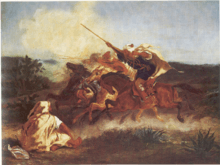Fantasia (performance)

Fantasia is a traditional exhibition of horsemanship in the Maghreb performed during cultural festivals and to close Maghrebi wedding celebrations. "Fantasia" is an imported name, the actual traditional term used is lab el baroud ("the gunpowder play").[1]
The performance consists of a group of horse riders, all wearing traditional clothes, who charge along a straight path at the same speed so as to form a line, and then at the end of the charge (about two hundred meters) fire into the sky using old muskets or muzzle-loading rifles.[2] The difficulty of the performance is in synchronizing the movement of the horses during acceleration of the charge, and especially in firing the guns simultaneously so that one single shot is heard. The horse is referred to as a fantasia horse and are of Arabian horse, Andalusian horse or Barb stock.[3]
The fantasia is considered a cultural performance and a kind of martial art;[4] it also symbolizes a strong relationship between the man and the horse, as well as an attachment to tradition.[5]
Each region in Morocco has one or several fantasia groups, called serba, totaling thousands of horse riders nationwide. Performances are usually during local seasonal, cultural or religious festivals, also called moussem ("season" in Arabic). One such example is the Tan-Tan Moussem. Some show-based restaurants offer a fantasia as part of the entertainment.[6]
Origins
The history of Fantasia probably is rooted in the horsemanship of North-Africa. The first remains of the ancestor of the horse as we know it, dates 40,000 years. The ’Equus Caballus algericus'. Rock paintings in the Saharan Atlas dating over 9 000 BC show the presence of horses in the Maghreb, horses that we believe are ancestors to the local breed:Barb.
Obedient rustic, resistant, but mostly fast, this horse will bring glory to the riders of Numidia, considered at the time of the Punic warriors as the best in the world, mostly thanks to their combat techniques that were essentially based on harassment. This technique was onslaught and fast retreat. This onslaught and fold technique (called by the Arabs: el-kerr ul-ferr), allowed for riders to galop as fast as they could, screaming and shooting their guns and immediately galloping back in a fold, reloading their weapons and coming back charging.
This is the origin of the Fantasia as it remains today with local variations in terms of numbers both of horses and riders or even figures that the modern riders present. To some it has turned into a folk event, yet the danger of riding these stallions (sometimes mere, like in the Eastern region of Algeria) and the use of real gunpowder makes this event very impressive.
The first representation of a Fantasia is a fourteen century drawing attributed to the Flemish painter Jan Cornelisz Vermeyen (1500-1559), named ex-post "A Fantasia in Tunis", as well as two other drawings titled 'Military Tournament", all painted during the Conquest of Tunis by the Emperor Charles Quint in 1535.
Fantasia in art
Some French, Sri Lankan and other Western artists have done oil paintings of the fantasia, including Edmon Vales,[7] Eugène Delacroix, Étienne Dinet, Théo van Rysselberghe, Amiru K and Eugène Fromentin.
References
- ↑ Burton Holmes (1919). Burton Holmes Travelogues. Travelogue Bureau. p. 99.
- ↑ Philip Durham Trotter (1881). Our Mission to the Court of Marocco in 1880: Under Sir John Drummond Hay ... D. Douglas. p. 342.
- ↑ Jackie Budd (1 January 1998). Horse and Pony Breeds. Gareth Stevens Publishing. p. 40. ISBN 978-0-8368-2046-1.
- ↑ Arabies (114-120 ed.). Arabies. 1996. p. 65.
- ↑ Deborah Anne Kapchan (1996). Gender on the Market: Moroccan Women and the Revoicing of Tradition. University of Pennsylvania Press. pp. 205–206. ISBN 0-8122-1426-9.
- ↑ Emmis Communications (April 1986). Orange Coast Magazine. Emmis Communications. p. 119. ISSN 0279-0483.
- ↑ "Fantasia au Maroc". artnet.com.
External links
| Wikimedia Commons has media related to Fantasia (Maghreb). |
_%D0%B2_%D0%A2%D0%B0%D0%BD-%D0%A2%D0%B0%D0%BD%D0%B5_(%D0%9C%D0%B0%D1%80%D0%BE%D0%BA%D0%BA%D0%BE).jpg)